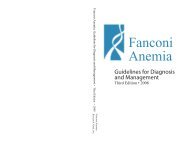FA Family Newsletter Fall 04 - Fanconi Anemia Research Fund
FA Family Newsletter Fall 04 - Fanconi Anemia Research Fund
FA Family Newsletter Fall 04 - Fanconi Anemia Research Fund
You also want an ePaper? Increase the reach of your titles
YUMPU automatically turns print PDFs into web optimized ePapers that Google loves.
Recurring Clonal Chromosomal AbnormalitiesBetsy Hirsch, PhD, University ofMinnesota School of Medicine, presenteddata on the frequency, types,and clinical associations of clonalchromosome abnormalities in <strong>FA</strong>patients. The data were based on 99<strong>FA</strong> patients, of whom 80% wereevaluated during assessment for bonemarrow transplant. Fifty-six percentof the patients had normal chromosomefindings; 44% had one or moreclonal abnormalities. The probabilityof having a chromosome abnormalityincreased with patients’ age: themean age of those with normal chromosomefindings was 9.2 years comparedto 14.4 years for those withabnormalities. Seventy percent ofthose patients 20 years or older hadan abnormal clone.Chromosome abnormalities wereidentified by standard techniquesutilizing G-banding. Fluorescence insitu hybridization (FISH) was oftenused to supplement the G-bandedstudy to confirm the exact characterizationof the abnormality. The vastmajority of abnormalities found werestructural chromosomal abnormalitiesresulting in either a net gain or anet loss of chromosome material.The most frequently seen abnormalitieswere a gain (i.e., an extracopy) of material from the long armof chromosome 3, loss of most of thelong arm of chromosome 7 or loss ofone entire copy of chromosome 7,and gain of material from the longarm of chromosome 1. Of the 44%of patients with clonal abnormalities,77% involved these chromosome 1,3, and/or 7 abnormalities.There was a significant correlationbetween the hematopathology findings(evaluated by a hematopathologist)and the presence of clonalabnormalities. Two-thirds of patientswith abnormal clones were diagnosedBetsy Hirsch, PhDwith myelodysplastic syndome(MDS) or acute myeloid leukemia(AML) based on the abnormalappearance (morphology) of thebone marrow cells. One-third ofpatients with abnormalities had noapparent MDS or AML. Follow-upcontinued on page 18Clone with Chromosome 3 AbnormalityPredicts Poor OutcomeThe <strong>Fall</strong> 2002 issue of the <strong>FA</strong> <strong>Family</strong> <strong>Newsletter</strong> reported on findingsfrom Germany that a subtle chromosomal abnormality on chromosome 3was associated with a high incidence of myelodysplastic syndrome (MDS)and acute myelogenous leukemia (AML) in <strong>FA</strong> patients. At our April 20<strong>04</strong>Cytogenetics Workshop, Heidemarie Neitzel, PhD, Institute for HumanGenetics, Charité, Berlin, updated participants on the earlier findings.In the original study, 18 patients had the same subtle abnormality onchromosome 3 (gains of the chromosomal segment 3q26q29); 35 did not.As of June 20<strong>04</strong>, only 5 patients with this abnormality were alive; 33 of 35without this clone were living. Neitzel repeated her earlier concerns:• This particular clone represents an ominous finding in <strong>FA</strong> patients.• It does not disappear from the marrow, but becomes more dominant.Heidemarie Neitzel, PhD• It is often associated with other ominous clones, especially monosomy 7(8 of the 18 patients also had monosomy 7).• Patients with this clone should strongly consider a bone marrow transplant.Routine cytogenetics analysis is usually insufficient to diagnose this abnormal clone. Neitzel stated that FISH(fluorescence in situ hybridization) is often necessary for accurate diagnosis. Using FISH with peripheral blood canalso detect this clone, but the procedure is too new to use blood alone; one must also examine the bone marrow. ◆<strong>Fall</strong> 20<strong>04</strong> 3
















